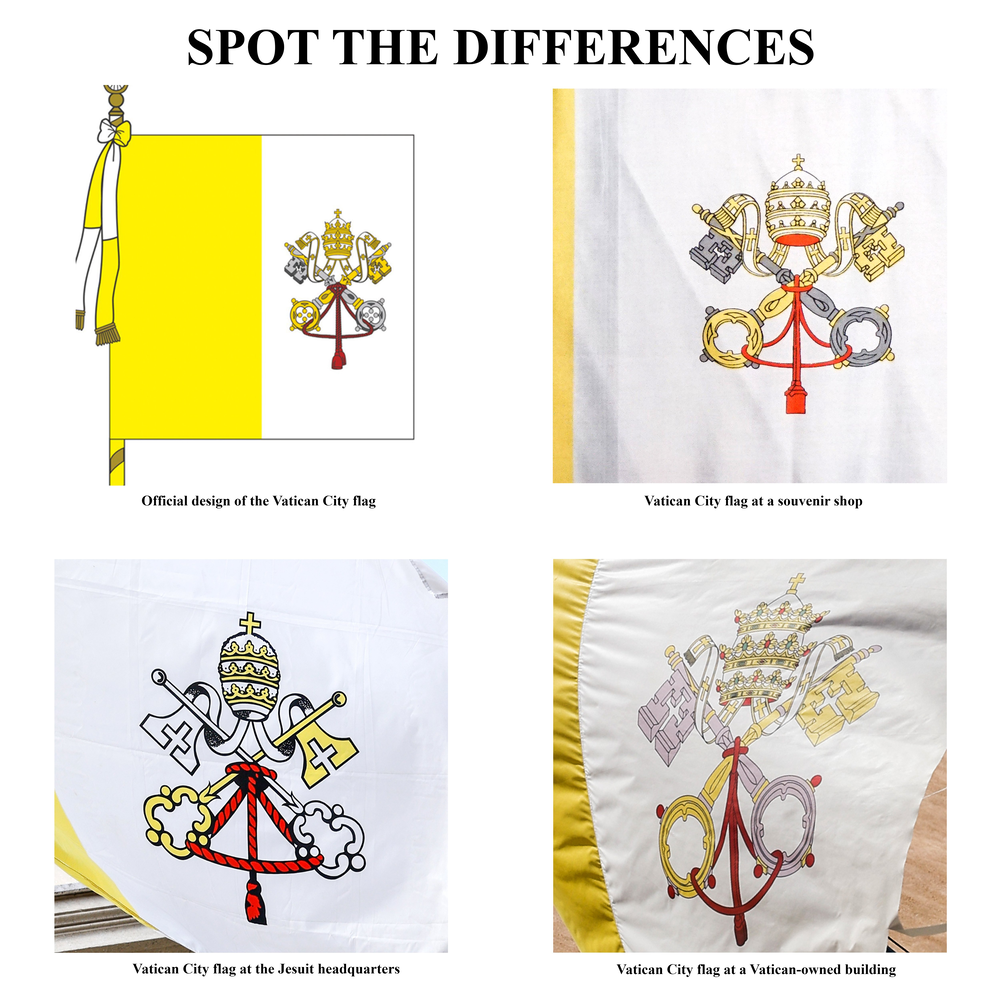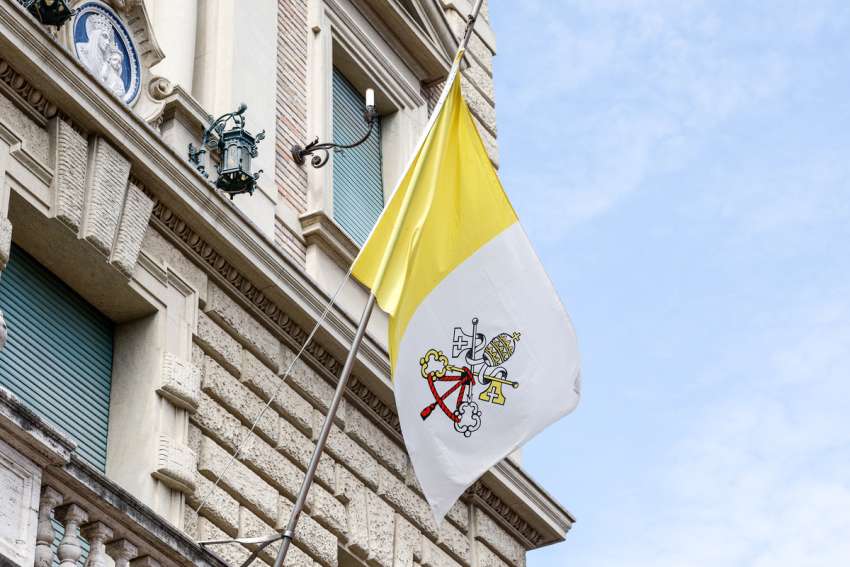VATICAN CITY -- The flag of Vatican City, yellow and white with crossed keys under the papal tiara, is incorrect in many emojis, flying outside the United Nations and often even on Vatican buildings.
Through confusion possibly caused by an erroneous Wikipedia entry, the Vatican flags waving outside its buildings and sold in Roman souvenir shops differ from the official design first published by the Vatican in 2000.
In that official illustration of the flag, the base of the papal tiara over the crossed keys is white. Yet for more than five years, the flag displayed on the Vatican City Wikipedia page depicted the tiara's base as red. The correct version with a white base was uploaded in January 2023 after a back-and-forth on an internal Wikipedia forum.
As the top Google search result for "Vatican flag" and one of the only high-quality images available in the public domain, the flag formerly displayed on Wikipedia became the most commonly sold version in Roman souvenir shops.
And the error appears to have seeped into the Vatican itself as can be noted on the different versions of the flag waving outside Vatican-owned properties.
 CNS graphic/Lola Gomez
CNS graphic/Lola Gomez
On the facades of the many Vatican properties that line Via della Conciliazione, the long road leading to St. Peter's Square, no two Vatican flags are the same. Some have papal tiaras with red bases while others are white. Some tiaras have colored jewels on them while others are solid gold. And almost all of them have very different looking lappets, the decorative flaps attached to the papal tiara that resemble those on a bishop's miter.
Where all the flags come from isn't exactly clear.
The Floreria Apostolica Vaticana is the Vatican office responsible for the provision, set up and maintenance of Vatican furnishings, covering everything from the plastic chairs put out for papal audiences in St. Peter's Square to the art on Vatican office walls -- as well as for the flags flying on its buildings. In response to an email inquiry, a Floreria official told Catholic News Service June 1 that the flags used in the pope's residence at Domus Sanctae Marthae and in the Apostolic Palace's San Damaso Courtyard, where heads of state arrive when meeting the pope, are all produced by the same flag maker outside of Rome.
Yet the official noted that the Floreria, which also provides furnishings to the Vatican's "extraterritorial" properties in Rome -- Vatican-owned buildings outside the walls of Vatican City -- had never received a request for a flag from an extraterritorial Vatican property.
The doorman at one of those properties, a Vatican-owned office building which had an incorrect and tattered flag over its door, told CNS June 1 that the building gets its flags online or "from one of the shops around the building."
The top result for "bandiera Vaticana" (Vatican flag) on Italian Amazon is a flag with the incorrect red base under the papal tiara.
According to Graham Bartram, chief vexillologist, or flag expert, at the U.K.-based Flag Institute, discrepancies on even official national flags are common.
"What you often find in government is that there is no department or person responsible for flags, and so there is likely no one walking around the Vatican area of Rome and going into buildings to say, 'Get the correct flag,'" he told CNS in a phone interview May 31.
Asked about the differences among the flags on Vatican properties, the Vatican press office told CNS that the Vatican City flag has not been altered since the first official illustration was published in 2000. But virtually no Vatican properties outside the walls of Vatican City use that flag today.
Prior to the illustration published in 2000, only a description of the flag was provided in Vatican City's Fundamental Law from 1929, the year the micronation was founded. It specified that the flag was a "drape split in yellow and white," featuring, "in the center of the white, crossed keys surmounted by the papal tiara."
Bartram said that prior to the late 20th century, uniformity among flags was a rarity since flag makers would rely on descriptions of a flag's design and create their own artistic interpretation of the flag, rather than reproduce a standardized image.
The differences in the Vatican City flag, he said, are likely the result of different flag makers "who thought, for instance, the tiara would look prettier with colored jewels on it."
Apple's Vatican City flag emoji features a tiara with those colored jewels, which have never been included in the Vatican's official flag illustrations, and several Vatican buildings have the jewels on their flags as well.
"Virtually every flag in the world we manage to get wrong in some way or another: shades of color, proportions, angles," Bartram told CNS. "The more complicated the flag the more variations you're going to spot."
And those variations can make their way into official uses. For example, the Vatican City flag outside the U.N. headquarters in New York, where the Holy See has permanent observer status, has a tiara with a red base.
In this instance, Bartram said the United Nations "would have made a flag based on the best information they had, and they would have shown it to the Vatican ambassador to get approval."
"The problem is that the Vatican ambassador is a senior clergyman and not a vexillologist," he said.


